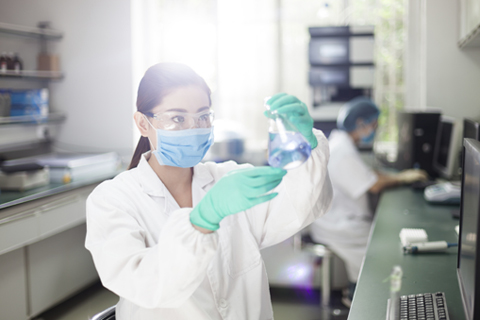For the last decade, scientists with the Structural Genomics Consortium (SGC), a public-private partnership with biomedical research operations at the University of Toronto and the University of Oxford, have investigated proteins that function by interacting with other proteins. Over the past four years, the group has helped discover that one kind of protein-protein interaction can be a target for medicines.
With advice from researchers at GlaxoSmithKline, the SGC team, together with a university scientist in Boston, produced an “inhibitor” that killed cancer cells. What’s unusual is what happened next. “We gave away this compound to anyone with no strings attached,” says Aled Edwards, the consortium’s chief executive officer and a professor of medical biophysics at U of T. “Other scientists used the ‘open-access compound’ to make equally important discoveries.”
The result: more than 25 companies are now doing more research into the compound and several already have drugs in Phase II clinical trials.
“We probably shaved three years off the normal time cycle of drug discovery.”
This happened because the participants didn’t lock up key discoveries with patents. Indeed, SGC was established to reduce the duplication of effort in academe and industry – and to demonstrate that there’s a faster and far less expensive way to discover drug treatments – all hinging on open access to research. Like a growing number of biomedical researchers, Edwards – who held the Banbury Chair of Medical Research at U of T’s Donnelly Centre – believes the global drug development process is broken. The pharmaceutical industry spends huge amounts researching and creating drugs that, when tested, prove to be ineffective, says Edwards (such as the more than $30 billion that has been spent chasing a cure for Alzheimer’s disease). The net effect is that drug costs are often staggeringly high, which squeezes governments’ health budgets.
“What is utterly apparent to all the participants is that the ecosystem in which we make medicines is non-functioning.” The consortium’s goal is to derive the structures of hundreds of human proteins and make those findings widely available. Although SGC – with an annual budget of about $10 million in each location – is still a tiny player in the $200-billion global biomedical research industry, Edwards is confident the group’s core idea – that important biomedical discoveries mustn’t be locked up by for-profit corporations or universities – could cure what ails the drug industry.
So far, the consortium’s 200 scientists have derived the structures for more than 1,500 human and parasite proteins, with the results deposited in a publicly accessible database. The Toronto group has done the same with the molecular blueprints for 14 “chemical probes” (the Oxford group for 10 more). Designed to insert themselves into cells carrying disease-related proteins, these molecules are mixed with the cells to determine if the probes disrupt the disease process. During the first five years of its existence, SGC sought to show a highly skeptical pharmaceutical industry that its open model would accelerate research and development.
GlaxoSmithKline invested in 2004, and launched the chemical- probes initiative with the consortium in 2009; since then eight other companies have joined. SGC has also developed relationships with foundations and hospitals that conduct research into disease. “Slowly, you can see the patent-free space expanding.”
While SGC’s private-sector backers collaborate on projects, they don’t enjoy better access to the science. Edwards’ goal isn’t just bringing in new financial supporters to underwrite the consortium’s patent-free research. He argues that the biomedical research community could actually develop a radically different business model for drug development by making much more of the building-block research widely available to researchers both inside and outside industry. Edwards believes that many scientists want to extricate themselves from a system that privatizes scientific knowledge instead of fostering innovation.
“We’re all looking at the problem from the confines of what the world currently looks like,” he observes. “There is no reason that medicines cannot be invented in the open.”
Recent Posts
For Greener Buildings, We Need to Rethink How We Construct Them
To meet its pledge to be carbon neutral by 2050, Canada needs to cut emissions from the construction industry. Architecture prof Kelly Doran has ideas
U of T’s 197th Birthday Quiz
Test your knowledge of all things U of T in honour of the university’s 197th anniversary on March 15!
Are Cold Plunges Good for You?
Research suggests they are, in three ways





